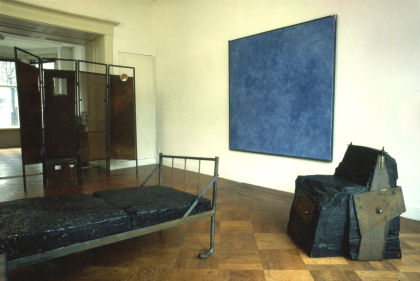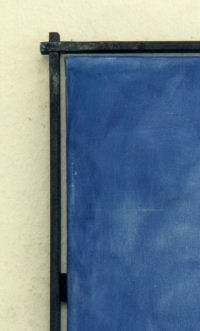|
|
 Death Room Interior, 1985 Death Room Interior, 1985
(WB archive1985-006)
Materials: Carbon H5, iron, wood, bitumen.
Size: not specified.
Canvas: Acrylic on gesso on canvas. Iron frame. Size: not specified.
Drawings: 1985-010/11 Siberian chalk on coal dust prepared paper, iron frame 118,5x 148,5cm.
1985-012/19) Siberian chalk on coal dust prepared board, carbon paper, iron frame 40x50cm
Photo documentation: Waldo Bien Archive, F.I.U. Amsterdam.
Coalmine Fürst Leopold Wulfen, Dorsten Germany. Atelier Waldo Bien, Ceres building/Amsterdam. Exhibit Rotterdam Art Space, 1986. Exhibit Kunsthalle Recklinghausen 2000 ( Ferdinand Ullrich)
Engaged for over more than 35 years in continual sculptural research, including drawing, painting and anthropology, the Death Room Interior is a ‘work in process’ made of coal from the Ruhr Region in Germany. It represents the culmination of a re-thinking of the problem of pedestal and space, which started since 1970, and re-location of the problem of light and colour theory.
 The Death Room Interior was made in the German coalmine Fürst Leopold Wulfen in Dorsten, at a depth of 860 meters. The location was registered H5. It was carved out of the coalface. The inter relationship between material depth, and the movement of light, corresponds to research conclusions based on the colour theory of Goethe and the spiritual thinking of Rudolf Steiner. The Death Room Interior was made in the German coalmine Fürst Leopold Wulfen in Dorsten, at a depth of 860 meters. The location was registered H5. It was carved out of the coalface. The inter relationship between material depth, and the movement of light, corresponds to research conclusions based on the colour theory of Goethe and the spiritual thinking of Rudolf Steiner.
In a simple image one may say that the light, which goes into the earth and through the darkness below, achieves again in the deepest dense sediments another form of light, as crystal or diamond. This double movement of interiority allows the spatial and physical conception of life and death a new location. The Death Room Interior is spatially conceived through the resolution of colour theory.
Working at the coal face Bien also produced a series of drawings. These Hochdruck Zeichnungen, ‘ high pressure’ drawings, accompany the exhibition of the Death Room Interior. Later the coal dust from the sculpture was handed to Virgil Grotfeldt and became a significant medium in the development of the artists, and part of the vessel of communication between them over many years, resulting in a series of complex and fascinating exchanges between Europe and America. The open ended-ness of their mutual collaborations is seen by Bien as part of the ’work in process’ and includes the ‘footnotes’ supplied by Grotfeldt to the Death Room Interior in 1994.
One can trace through the decades that follow the influence on many aspects of his production of this pivotal work in his entire oeuvre, resulting in works on paper, paintings, collaborations with other artists, sculptures and even providing a source for his literary activity in the writing of short-stories and essays.
Further see: Waldo Bien Book, Chapter 5
|
|